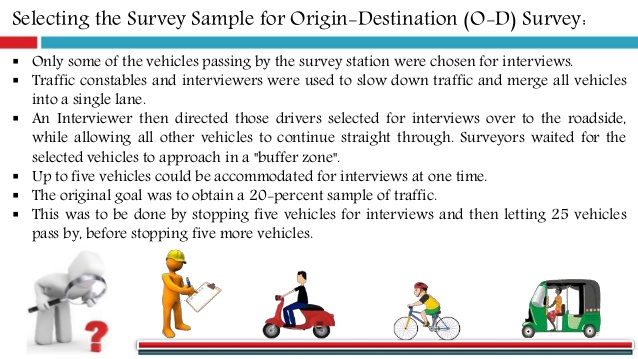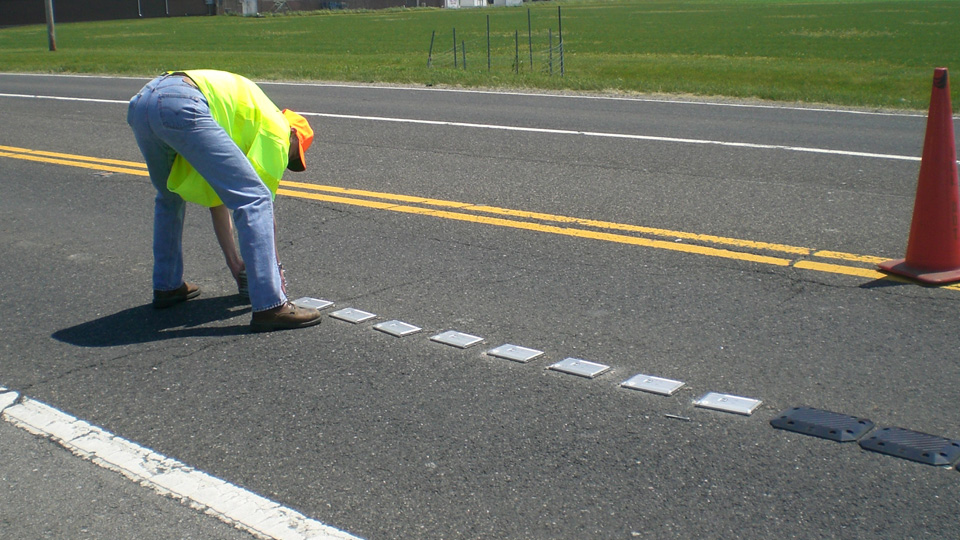
1. When a new road is being planned, or extensive improvements are to be carried out to an existing road, or a bypass is under consideration, the amount of traffic likely to use it cannot be ascertained from a simple census and it may become necessary to collect information about the origin and destination of traffic passing through the area in which the road is situated. The origin and destination data should be comprehensive enough to cover all roads likely to be affected by the proposed scheme. The points at which the data is collected should be carefully chosen on the road network such that it should be possible to derive the volume of traffic likely to use the facility under consideration.
2. The survey should normally be conducted for three consecutive days, on sample basis if possible during a representative week in the year and must encompass the weekly market day and one working day. For exceptional cases, in heavy density corridors and where the daily variation in the traffic is not much, at least one day's survey may be conducted on a normal working day. Care shall be taken during interpretation of the data keeping in mind the seasonal variation of traffic.
3. There are several methods available for conducting an O-D survey. Information on them is contained in IRC: 102 'Traffic Studies for Planning Bypasses Around Towns'. Generally, the "Roadside Interview Method" is well-suited for roads in rural areas and can be conveniently adopted. This consists basically of interviewing drivers of vehicles at suitably located points with reference to the type of road scheme in consideration. At these stations, the number as well as the type of all vehicle passing the station is recorded. However, only a percentage of the drivers at random need to be stopped and interviewed for origin, destination and other travel particulars, like, commodity carried. The sampling should be systematic. Generally, 1 5 to 20 per cent of the vehicles may be covered in the peak periods and 25 to 30 per cent in the normal periods.
4. The sample should be up scaled to ADT and preferably hourly based classified vehicle type. The location of origin and destination zones will be determined in relation to each individual station and the possibility of traffic diversion to the project road fi*om other road routes including bypasses. In principle, the zoning should bisect areas where competing roads pass and the zonal configuration shall be adequate on either side of the O-D station; thereafter, districts will serve as zones with the State. Zoning outside the State will relate to individual or groups of States in accordance with the distance fix)m the OD station. For coding purposes, code lists or code maps (to be shown to motorists) will be prepared giving zone number and towns within that zone. The updated (ADT) numbers shall then be presented by trip matrix. Information on weight for trucks should, following up scaling to ADT, be summed up by commodity type and the results tabulated, giving total weight and average weight per truck for the various commodity types. Following processing of the O-D results, traffic is assigned from the trip matrix's elements to the project road's homogeneous sections, provided the route including the project road in its improved condition is the most desirable of the alternative routes available in terms of least vehicles operating costs
Axle load survey is needed to generate data for pavement design. Portable weighbridges are very useful for this purpose. This survey shall be carried out along with classified volume count survey. Number of days of survey will depend on project location, the type of project and the intensity and expected variation in traffic. This survey duration may vary between 24 hours and 3 days, but should be carried out at least for one day at the traffic count stations on a random basis for commercial vehicles. Buses maybe omitted as their weight can be easily calculated and they do not result in excessive overloads.The period of conducting the survey should also be judiciously selected keeping in view the movement of commodity/destination oriented dedicated type of commercial vehicles.
While finalising the design Equivalent Standard Axle load, the following should be consider
Past axle load spectrum in the region as well as on the road to the extent available.
Annual variation in commercial vehicles.
Optimistic and pessimistic considerations of future generation of traffic.
Generation of changing VDF factor during the project period.

Highway improvements result in spring up traffic and reducing congestion. Speed and delay studies on the existing facility provide the basis for estimating the causative problems and benefits of the improved facility. For this purpose typical performance. 2(a) and (b) given in this chapter may be used.
The study is conveniently conducted by the "Moving Observer" method. By this method a test vehicle is run along with the traffic stream, at approximately the perceptible average speed of the traffic stream. A separate run is needed for each direction. The average of around six runs ensures accuracy of results. By noting down the travel time, including actual running time and stopped delays, the vehicles counted in the opposite direction and those overtaken/overtaking, it is possible to calculate the volume, speed and delay. For further information, IRC: 102 "Traffic Studies for Planning Bypasses Round Towns" maybe consulted. performance 3(a) to (d) given in this Chapter may be found useful for this survey
In order to assess intersections turning movement counters (TMC's) are used to quantify the movement of vehicles through the area. These TMC's are square shaped boxes that have buttons for each direction of traffic flow. For example, east bound traffic entering an intersection has a button for those vehicles that turn, left, right or continue straight. Furthermore, an additional button is used for each direction to add the number of pedestrian and bicyclist movement. Typically automated traffic counters assess traffic flows, however, due to the differing angles of vehicles entering an intersection the present technology available is not able to quantify the traffic without major error. Traditional automated traffic counters have rubber tubes which are laid out across the road generally in a straight portion in order to have the wheels on the same axle hit at about the same time. When turning in an intersection the tires hit individually and the amount of error in the counter is increased. This means that TMC's are the only present option for quantifying traffic flows. They are used manually by an individual pressing the correlating button for every vehicle that enters and moves through the intersection. TMC's are generally used to determine whether the intersection needs a traffic light. Equations are used to decide whether the volume of the traffic determines that a light is needed. This equation is based on the road classification, entering speed and pedestrian/bicyclist movement through the intersection. A total of eight hours of turning movement is generally mandated for this type of assessment.

A Traffic surveying consultancy service is used for making essential measurements to determine the relative position of points and/or physical and cultural details above, on, or beneath the surface of the Earth. These depict the points in a usable form, or to establish the position of points and/or details. Our topographic surveying professionals have the capability of handling combinations of topographic maps, which enable them to come up with accurate results.

© 2019 Narendra Geotechnical. All rights reserved